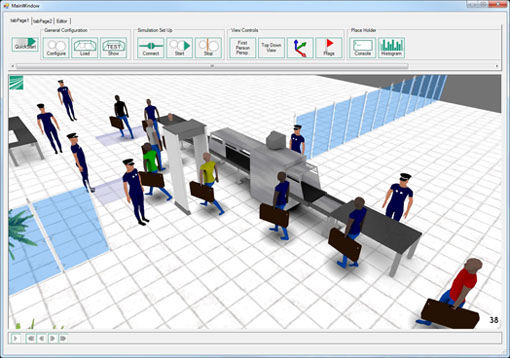Airline passenger screening – judging quality, comfort and efficiency

Security checkpoints are of special importance for the security of airports. Fraunhofer EMI develops a method to evaluate the quality, comfort and efficiency of airport security checkpoints. The facilities have to be flexible with regard to changing threat situations and, at the same, time easy to handle for the personnel concerned. Passengers demand protection of their personal rights and travel comfort – both at the highest possible level. Due to increasing requirements, security checks at airports take up more and more room and compete with gastronomy and shopping facilities which constitute profitable business for airport operators.
Requirements are also growing more complex: According to a television report, the European Commission has revealed serious security risks at a German airport checkpoint: For several times, investigators smuggled weapons through the checks (source: dpa, ZDF (German public television), December 12, 2014). The report states that the European Commission threatens to classify this airport as a “non-Schengen airport” if requested measures will not be effective. This implies that air passengers passing though this airport will have to undergo a security check anew once they enter other EU countries.
The results published at the end of December 2014 and their possible consequences demonstrate the relevance of checkpoints to the entire airport operation.
Within the research program XP-DITE, Fraunhofer EMI and its partners develop a method to assess the quality and, at the same time, the comfort and efficiency of security checkpoints at airports. This method determines the security level by means of sophisticated simulation, and it also identifies the time exposure for passengers and the system costs for the operators. In the future, this will sustainably improve the airport security and enhance the comfort for the airport occupants as well as airport economics.
Using modern and interconnected technology today allows for faster passenger controls which guarantee more security. However, until now, security systems are evaluated component-by-component which impedes the optimization of the overall system.
The evaluation platform developed by EMI makes it possible to evaluate all interconnected components at the same time on a systematic basis. By functional interaction with, e.g., commercial design tools for security checkpoints, the EMI software allows for extensive analysis and optimization already during the design phase. This way, secure and passenger-friendly concepts can be introduced for airport security in the future. As a consequence, airports can use their limited space more efficiently while offering a high security level, and passengers reach their gate more quickly and in a more pleasant way.